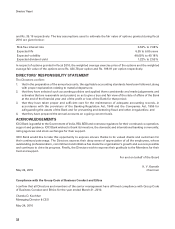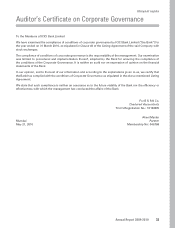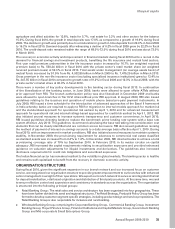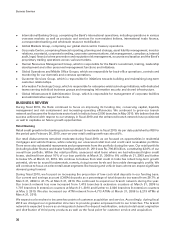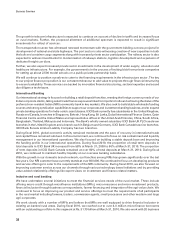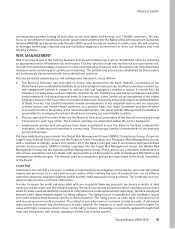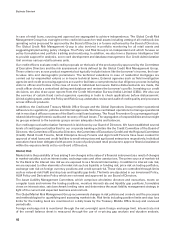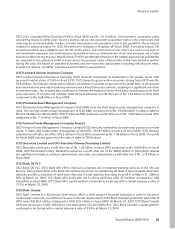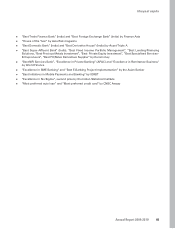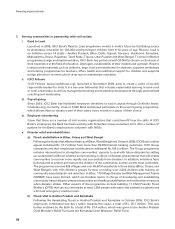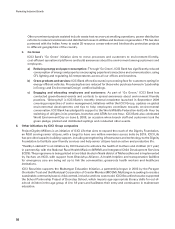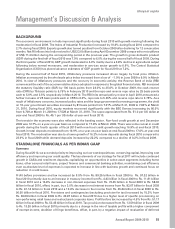ICICI Bank 2010 Annual Report Download - page 43
Download and view the complete annual report
Please find page 43 of the 2010 ICICI Bank annual report below. You can navigate through the pages in the report by either clicking on the pages listed below, or by using the keyword search tool below to find specific information within the annual report.
We prepare interest rate risk reports on a fortnightly basis. These reports are submitted to RBI on a monthly
basis. Interest rate risk is further monitored through interest rate risk limits approved by the Asset Liability
Management Committee.
Risks on trading positions are monitored and managed by setting VaR limits, counterparty limits and stipulating
daily and cumulative stop-loss limits. Liquidity risk is measured through gap analysis. We maintain diverse sources
of liquidity to facilitate flexibility in meeting funding requirements. Incremental operations in the domestic market
are principally funded by accepting deposits from retail and corporate depositors. The deposits are augmented
by borrowings in the short-term inter-bank market and through the issuance of bonds. Loan maturities and sale
of investments also provide liquidity. Most of the funds raised are used to extend loans or purchase securities.
Generally, deposits have a shorter average maturity than loans or investments. Our international branches are
primarily funded by debt capital market issuances, syndicated loans, bilateral loans and bank lines, while our
international subsidiaries raise deposits in their local markets.
Operational Risk
Operational risk is the risk of loss resulting from inadequate or failed internal processes, people and systems or
from external events. It includes legal risk but excludes strategic and reputation risks. Operational risks in the Bank
are managed through a comprehensive internal control framework. The control framework is designed based on
categorisation of all functions into front-office, comprising business groups; mid-office, comprising credit and
treasury mid-offices; back-office, comprising operations; and corporate and support functions.
ICICI Bank’s operational risk management governance and framework risk is defined in the Operational Risk
Management Policy, approved by the Board of Directors. While the policy provides a broad framework, detailed
standard operating procedures for operational risk management processes are established. The policy is applicable
across the Bank including overseas branches and aims to ensure clear accountability, responsibility and mitigation
of operational risk. We have constituted an Operational Risk Management Committee (ORMC) to oversee the
implementation of the Operational Risk Management framework. The policy specifies the composition, roles and
responsibilities of ORMC. The framework comprises identification and assessment of risks and controls, new
products and processes approval framework, measurement through incidents and exposure reporting, monitoring
through key risk indicators and mitigation through process and control enhancement and insurance. We have
formed an independent Operational Risk Management Group for design, implementation and enhancement
of the operational risk framework and to support business and operation groups in carrying out operational
risk management.
Compliance
The Bank has a dedicated compliance group for ensuring regulatory compliance across all its businesses and
operations. The key functions of this group include identification and assessment and compliance related matters,
review of new products and processes from a regulatory compliance perspective and ongoing monitoring and
reporting. The Bank has also put in place a group wide anti-money laundering policy approved by the Board
of Directors and Know Your Customer and transaction monitoring procedures as per RBI guidelines. The Bank
reviews these policies and procedures from time to time.
TREASURY
Our treasury operations are structured along the balance sheet management function, the client-related corporate
markets business and the proprietary trading activity.
During fiscal 2010, financial markets stabilised to a significant extent but continued to remain volatile based on
global developments. The government bond markets witnessed an 80 basis points increase in benchmark yields
following the large government borrowing programme, emergence of inflationary concerns and the initiation of
withdrawal from an accommodative monetary policy stance. Our balance sheet management function during fiscal
2010 continued to actively manage the government securities portfolio held for compliance with SLR norms to
optimise the yield on this portfolio, while maintaining an appropriate portfolio duration given the volatile interest
rate environment. The focus of our proprietary trading operations was to maximise profits from positions across
key markets including corporate bonds, government securities, interest rate swap, equity and foreign exchange
markets while building new and alternate channels of revenue. During fiscal 2010, we built a strategic credit book
41
Annual Report 2009-2010
khayaal aapka



